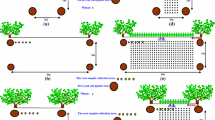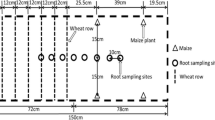Abstract
The objective of this experiment was to learn more about root morphology and spatial distribution in a specify walnut (Juglans regia L.)/wheat (Triticum aestivum L.) intercropping system. The effects of intercropping on aboveground yield and land equivalent ratio (LER) were also determined. The experiment was conducted at Hetian in the southern part of the Xinjiang Uyghur Autonomous Region. The results showed that walnut/wheat intercropping reduced the aboveground yield of both component species. However, the LER of the intercropping system averaged 1.62. This meant that intercropping increased land use efficiency. Intercropping significantly reduced the root length density, root surface area density, and root diameter (RD) of both component species compared with sole-cropping. In contrast, intercropping significantly increased the specific root length of walnut. Root competition between species was the greatest in the 0–40 cm soil depth. Root competition caused uneven distribution of RD and specific root length. The plasticity of root morphology and spatial distribution is key for adapting to competition and maximizing water and nutrient uptake in walnut/wheat agroforestry systems.









Similar content being viewed by others
References
Allen S, Jose S, Nair PKR, Brecke BJ (2004) Competition for 15 N labeled nitrogen in a pecan–cotton alley cropping system in the southern United States. Plant Soil 263:151–164
Allen S, Jose S, Nair PKR, Brecke BJ, Nair VD, Graetz D, Ramsey CL (2005) Nitrogen mineralization in a pecan (Carya illinoensis K. Koch)–cotton (Gossypium hirsutum L.) alley cropping system in the southern United States. Biol Fertil Soil 41:28–37
Anderson LS, Sinclair FL (1993) Ecological interactions in agroforestry systems. Agrofor Abast 6:57–91
Bingham IJ, Bengough AG (2003) Morphological plasticity of wheat and barley roots in response to spatial variations in soil strength. Plant Soil 250:273–282
Cai CF, Wang F, Ding SW, Huang L, Shi ZH (2000) Plant nutrient competition mechanism analysis between components in the intercropping and agroforestry systems. Res Soil Water Conserv 7(219–221):251
Cao FL, Kimmins JP, Wang JR (2012) Competitive interactions in ginkgo and crop species mixed agroforestry systems in Jiangsu, China. Agrofor Syst 84:401–415
Cardinael R, Mao Z, Prieto I, Stokes A, Dupraz C, Kim JH, Jourdan C (2015) Competition with winter crops induces deeper rooting of walnut trees in a Mediterranean alley cropping agroforestry system. Plant Soil 391(1–2):219–235
Carvalho CR, Clarindo WR, Praca MM (2008) Genome size, base composition and karyotype of Jatropha curcas L an important biofuel plant. Plant Sci 174:613–717
Casper BB, Jackson RB (1997) Plant competition underground. Annu Rev Ecol Syst 28:545–570
Feng GL (1994) Control the root-shoot ratio of dry matter distribution model, the utilization of water and nutrients. J Beijing Agric Univ 15:83–90
Gao Y, Duan AW, Liu ZD (2009) Crop root growth and water uptake in corn/soybean intercropping systems. J Appl Ecol 20:307–313
Gillespie AR, Jose S, Mengel DB, Hoover WL, Pope PE, Seifert JR, Biehle DJ, Stall T, Benjamin TJ (2000) Defining competition vectors in a temperate alley cropping system in the midwestern USA. 1. Production physiology. Agrofor Syst 48:25–40
Huxley PA, Pinney A, Akunda E (1996) A tree crop interface orientation experiment with a grevillea robust a hedgerow and maize. Agrofor Syst 26:23–45
Jose S, Gillespie AR, Seifert JR, Mengel DB, Pope PE (2000) Defining competition vectors in a temperate alley cropping system in the mid-western USA. 3. Competition for nitrogen and litter decomposition dynamics. Agrofor Syst 48:61–77
Jose S, Gillespie AR, Seifert JR, Pope PE (2001) Comparison of minirhizotron and soil core methods for quantifying root biomass in a temperate alley cropping system. Agrofor Syst 52:161–181
Jose S, Williams R, Zamora D (2006) Belowground ecological interactions in mixed-species forest plantations. For Ecol Manag 233:231–239
Li L, Yang SC, Li XL, Zhang FS, Christie Peter (1999) Interspecific complementary and competitive interactions between intercropped maize and faba bean. Plant Soil 212:105–114
Li L, Sun JH, Zhang FS, Guo TW, Bao XG, Smith FA, Smith SE (2006) Root distribution and interactions between intercropped species. Oecologia 147:280–290
Liu H, Duan AW, Gao Y (2006) Temporal and spatial distribution and variation of root system growth of the inter-planted winter wheat. J Irrig Drain Eng 25:20–24
Livsley SJ, Gregory PJ, Buresh RJ (2000) Competition in tree row agroforestry systems. 1. Distribution and dynamics of fine root length and biomass. Plant Soil 227:149–161
Ma CM, Zhai MP, Liu CP (2009) Root distribution characteristics of Juglans regia in mono culture and intercropping. J Beijing For Univ 31:181–186
Monteith JL, Ong CK, Corlett JE (1991) Microclimatic interactions in agroforestry system. For Ecol Manag 45:31–34
Mulia R, Dupraz C (2006) Unusual fine root distributions of two deciduous tree species in southern France: what consequences for modelling of tree root dynamics? Plant Soil 281:71–85
Ong CK, Corlett JE, Singh RP, Black CR (1991) Above and below ground interaction in agroforestry system. For Ecol Manag 45:45–57
Peng XB, Cai J, Jiang ZM, Zhang YY, Zhang SX (2009) Effects of light competition on agroforestry ecosystem productivity. J Ecol 29:545–552
Rao MRR, Sharma MM, Ong CK (1990) A study of the potential of hedge row intercropping in semi-arid India using a two-way systematic design. Agrofor Syst 11:243–258
Rao MRR, Sharma MM, Ong CK (1991) A tree–crop interface design and its use for evaluating the potential of hedgerow intercropping. Agrofor Syst 13:143–158
Robinson D, Hodge A, Fitter A (2003) Constraints on the form and function of root systems. In: Kroon HD (ed) Root ecology. Springer, Heidelberg, pp 1–26
Sanchez PA (1995) Science in agroforestry. Agrofor Syst 30:5–55
Schenk HJ (2006) Root competition: beyond resource depletion. J Ecol 94:725–739
Schroth G (1995) Tree root characteristics as criteria for species selection and system design in agroforestry. Agrofor Syst 30:125–143
Schroth G (1999) A review of belowground interactions in agroforestry, focusing on mechanisms and management options. Agrofor Syst 43:5–34
Singh RP, Ong CK, Saharan N (1989) Above and below ground interactions in alley-cropping in semi-arid India. Agrofor Syst 9:259–274
Smith MW, Wolf ME, Cheary BS, Carroll BL (2001) Allelopathy of bermudagrass, tall fescue, redroot pigweed, and cutleaf evening primrose on pecan. Hortic Sci 36:1047–1048
Thevathasan NV, Gordon AM (2004) Ecology of tree intercropping systems in the North temperate region: experience from southern Ontario, Canada. Agrofor Syst 61(1–3):257–268
Wang XC, Ma XM, Niu SL (1999) Study on the effect of regulators on development and physiology characteristic of tobacco root system. Acta Tabac Sin 5:33–38
Wang JX, Wang DH, Liu GQ (2004) Distribution characteristics of effective root density in the planted Robinia pseudoacacia and Platycladus orientalis forest site. Acta Bot Boreal Occident Sin 24:2208–2214
Wang BJ, Zhang W, Ahanbieke P, Gan YW, Xu WL, Li LH, Christie P, Li L (2014) Interspecific interactions alter root length density, root diameter and specific root length in jujube/wheat agroforestry systems. Agrofor Syst 88:835–850
Wei LY, Shang Guan ZP (2006) Specific root length characteristics of three plant species, Bothriochloa ischaemum, Hippophae rhamnoidess and Quercus liaotungens is in the Loess Plateau. Acta Ecol Sin 26(12):4164–4170
Wu G, Feng ZW (1994) Research fruit crop intercropping ecosystem functional characteristics. J Plant Ecol 18:245–252
Yun L, Bi HX, Ren Y, Wu J, Chen PP, Ma WJ (2008) Research on soil moisture relations among types of agroforestry system in the loess region. Bull Soil Water Conserv 28:110–114
Yun L, Bi HX, Ma WJ, Tian XL, Cui ZW (2010) Spatial distribution characteristics of root system of walnut–peanut intercropping system in the loess region of western Shanxi. J Northeast For Univ 38:67–70
Zamora DS, Jose S, Nair PKR (2007) Morphological plasticity of cotton roots in response to interspecific competition with pecan in an alley cropping system in the southern United States. Agrofor Syst 69:107–116
Zhang XQ, Wu KH, Murach Dieter (2000) A review of methods for fine-root production and turnover of trees. Acta Ecol Sin 20:875–881
Zhang JS, Meng P, Yin CJ (2002) Spatial distribution characteristics of fruit trees root in the composite system. For Sci 7:30–33
Zhang JE, Li YL, Huang DZ, Ma JJ, Liu JZ, Guo J (2007a) Mulberry root distribution pattern in mulberry tree–crop interplanting field and its influence on soil moisture and nutrients. J Soil Water Conserv 21:38–42
Zhang L, Vander Werf W, Zhang S (2007b) Growth, yield and quality of wheat and cotton in relay strip intercropping systems. Field Crop Res 103:178–188
Zhang W, Ahanbieke P, Wang BJ, Xu WL, Li LH, Christie P, Li L (2013) Root distribution and interactions in jujube tree/wheat agroforestry system. Agrofor Syst 87:929–939
Zhang W, Ahanbieke P, Wang BJ, Gan YW, Li LH, Christie P, Li L (2015) Temporal and spatial distribution of roots as affected by interspecific interactions in a young walnut/wheat alley cropping system in northwest China. Agrofor Syst 89:327–343
Acknowledgements
This work was financially supported by the NSFC (Project No. 31460335 and 31560376), by the Project Funded by China Postdoctoral Science Foundation, and by Scientific Research Funds for High Calibre Researchers of Shehezi University (Project No. RCZX201422). The authors also thank Dr. William J. Gale for his assistance in editing this manuscript.
Author information
Authors and Affiliations
Corresponding authors
Rights and permissions
About this article
Cite this article
Duan, Z.P., Gan, Y.W., Wang, B.J. et al. Interspecific interaction alters root morphology in young walnut/wheat agroforestry systems in northwest China. Agroforest Syst 93, 419–434 (2019). https://doi.org/10.1007/s10457-017-0133-2
Received:
Accepted:
Published:
Issue Date:
DOI: https://doi.org/10.1007/s10457-017-0133-2




